Recommendations
- Indexation and resourcing of State and Federal contracts must be sufficient to ensure award obligations can be met.
- Public authorities contract with the not-for-profit community services sector in a manner that supports sustainable and effective service delivery and greater parity in pay and conditions for community services workers.
- Support greater links and partnerships between training providers and community service organisations.
- Recognise the importance of worker training in procurement policies.
- Develop an Aboriginal workforce development strategy that provides incentives and support to increase Aboriginal employment in human services contracts.
- Establish requirements in State and Federal Government contracts to train and employ people within the local community with a focus on Aboriginal workers.
- Encourage and support early childhood centres to provide on-site training and professional development and provide scholarship funding to up-skill experienced staff to provide supervision and mentoring.
- Develop policies and incentives to retain existing skilled early education and care staff, including greater job certainty and improved employment conditions.
- Prioritise the development and provision of childcare services in regional areas as a key support for regional development outcomes.
- Reform funding of preschool care to better support community-based care and increase access to long day care.
- Engage with the Federal Government (via COAG and the National Jobs and Skills Summit) to discuss collaborative reform approaches to service delivery and funding models in aged care, disability and childcare services.
- Develop housing initiatives that ensure provision of accommodation for employees of Non-Government Organisations (NGOs) contracted and funded by the State or Federal Government to provide key services in regional locations.
- Incorporate housing costs into service delivery contracts with the State Government in high-cost regional locations to sustain the delivery of funded NGO services.
- Targeted transitional investment in job creation and training in areas of unmet and growing need, such as aged care, disability services, FDV services, ACCO services.
Introduction
WACOSS commends the State Government’s investment in workforce training and skills development, particularly in the critical areas of mental health and alcohol and other drug conditions. We support the fostering of stronger links to and pathways from education to training institutions and work placements that reduce barriers to employment for cohorts under-represented in the workforce.
We suggest that stronger focus is needed in on-the-job training and effective workplace supervision within human services, as many of the interactional complexities of community service occupations are not easily or effectively taught in classrooms but require real life experience. Greater recognition and support for experienced staff to take on supervision and mentoring roles will result in both improved service quality and improved workforce retention.
While WACOSS recognises that this strategy centres on developing a skilled workforce and focuses on key sections of the employee life cycle, including attraction, recruitment and skills development, we firmly believe that any workforce strategy must include a commensurate focus on job security and staff retention across key industries, especially in the health care and social assistance sector.
Retention is the single biggest challenge for community service organisations in the current economic cycle. The combination of slow sector wage growth and insecure employment contracts (a knock-on effect of ongoing short-term and last-minute funding contract rollovers arising from machinery of government changes – which should eventually be fixed by the State Commissioning Strategy) has led to significant numbers of skilled staff to leave the sector for better paid public sector or private sector roles.
Though it is imperative to focus on skills and training, we must follow the pipeline through to job design and job quality, ensuring that the nature of jobs in Western Australia supports worker retention and wellbeing. This, in turn, ensures that employment in Western Australia is attractive for workers, meets community expectations around workplace conditions and ultimately delivers higher quality services with better community outcomes.
Developing and sustaining a skilled community services workforce to meet projected need is becoming an increasing challenge, given the existing gap in skills and workforce capability across a number of service areas and a tightening funding environment. Safe, effective, connected, person-centred community services require a skilled, competent and proactive workforce with appropriate qualifications and experience to deliver high-quality services; these jobs cannot be automated. The diverse skill sets to meet industry needs has been outlined by the State Training Board in their Future Workforce Skills Report.[1]
Addressing the skilled worker shortage in the community services sector requires strategic investment to attract workers, not only through education, training, and qualifications, but also through improved wages, job security, workplace conditions and career pathways. Without such investment, the community service sector will experience significant impacts on their capacity to retain skilled workers and to service the increasing complexity of need spreading throughout our communities.
It is important that the way we respond to workforce development and retention issues is well-targeted and evidence based. There can be a tendency to talk about ‘skills shortages’ when we have a tight labour market and particular sectors are less able to attract or retain skilled workers; these workers may simply be choosing to pursue better opportunities elsewhere, thus creating a labour shortage, or a shortage of willing workers. Simply focusing on more training places and incentives in the VET and tertiary sectors without considering retention and career development may ultimately merely increase the churn rate.
In a tight labour market, we need to be focusing on increasing the workforce participation rate by addressing the barriers to work faced by key groups currently excluded from the labour force, including single parents and working mothers, skilled seniors, people with a disability, Aboriginal and migrant LBOTE workers, those on humanitarian visas and the under-employed. Tackling these barriers will require changes and better targeting of policy at state and federal levels, complemented by personalised support provided by local community services with knowledge and experience working with these marginalised cohorts.
The evidence on the scale, impact and projected future growth of the health care and social services workforce indicates that it is both the largest and fastest growing employment sector in Australia and WA, employing 14.3 per cent of WA’s workforce (184,900 people as of November 2021) and projected to grow by 14.5 per cent by 2025, requiring an additional 27,000 workers.[2] This means that we will need to be training more skilled workers through both VET and tertiary sectors and retaining and up-skilling existing workers and bringing in a migrant care workforce over the next decade to meet the needs of an ageing population and address projected demand in childcare, disability and aged care services. Other nations face exactly the same population ageing challenges and will be competing for migrant workers. In this context, we need to be acting now to both develop training and immigration pathways as well as tapping into our own latent workforce capability, enabling excluded workers, changing attitudes to the care professions, and ensuring the work is more secure and rewarding.
The focus of this submission will therefore centre on opportunities to better attract and retain workers and the systemic factors that contribute to worker shortages in the community service sector. Increasing retention rates through better job quality and training is a top policy priority to develop a skilled workforce, while broader factors such as affordable housing and placing a greater investment in community-based services must also be addressed, particularly in regional areas.
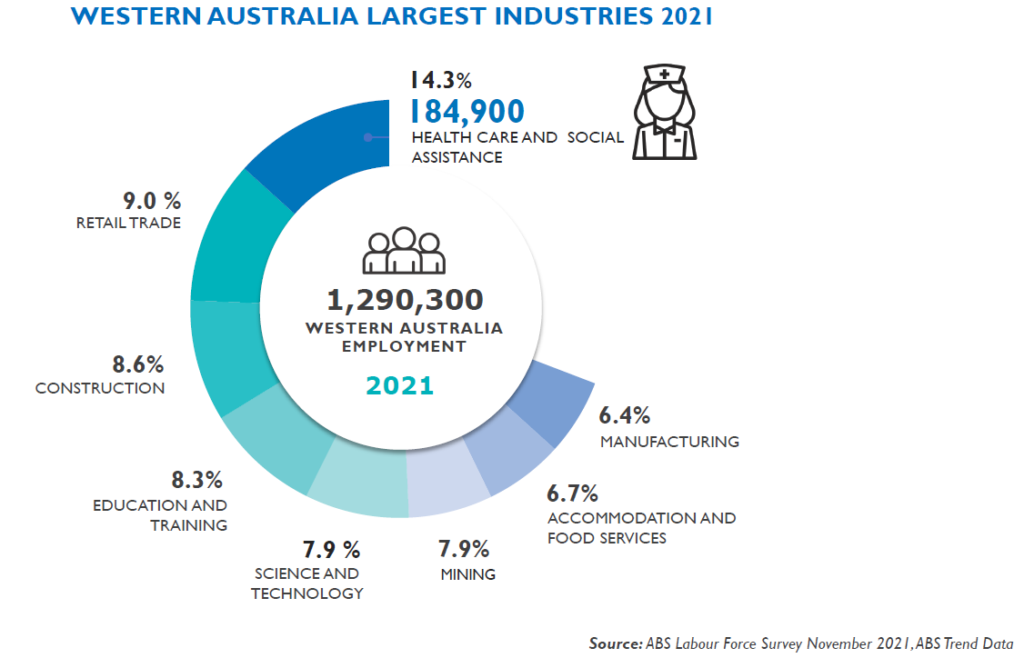
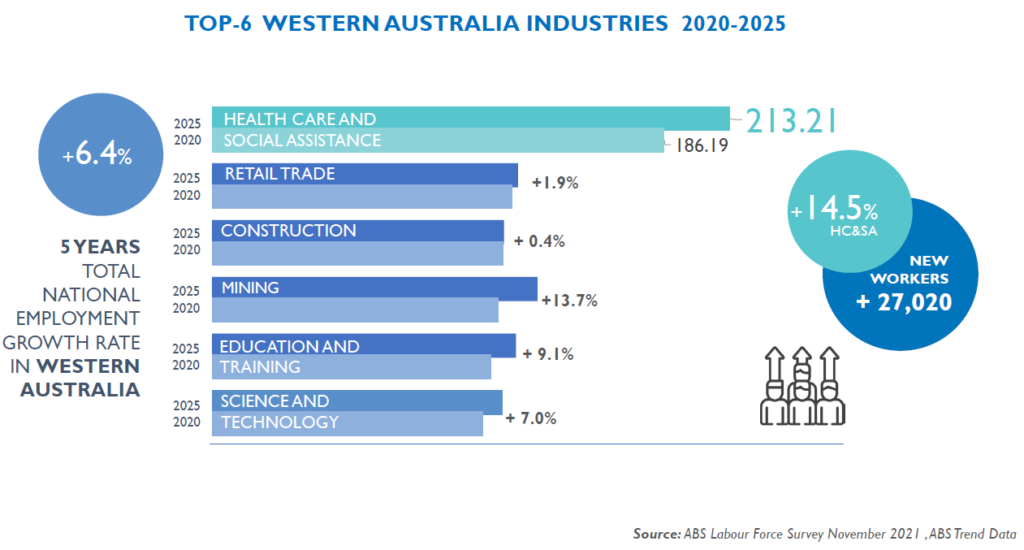 Adequate, sustainable funding for the community services sector
Adequate, sustainable funding for the community services sector
Unlike other areas of public service delivery such as education and health, that are founded on policies of universal entitlement and population or demand-based funding, social services continue to rely on ad hoc program-based funding models that seldom keep pace with community need or the true cost of service delivery. The uncertain funding environment constrains job security and employee confidence for their immediate future.
In addition, a significant gap between funding indexation and direct labour cost increases has been a consistent trend for community organisations for years in WA, as service contracts have continued to be rolled over rather than recommissioned. WA State Government indexation of 2.55 per cent under the Non-Government Human Services Sector (NGHSS) Indexation Policy will be applied to community sector funding for the 22/23 financial year. This level of indexation does not reflect the true increased costs for organisations, especially in light of the recent Federal and State award wage announcements.
The Western Australian Industrial Relations Commission announced a 5.25 per cent increase to the State Minimum Wage and a 4.65 per cent increase to WA Awards in its 2022 decision on the State Wage Case. Approximately 30 per cent of the WA community sector workforce is covered by the state system, and around 70 per cent by Federal Awards. When combined with the Superannuation Guarantee increase, the Fair Work Australia decision for the National Annual Wage Review results in a minimum 5.1% increase in labour costs for community organisations. Since the sector is comprised of people-centred social services, staff costs account for around 70-80 per cent of its running costs.
The difference between indexation and wage costs has been steadily growing over the last decade. Analysis estimates that this has resulted in a gap of 13.35 per cent to the real cost of service delivery.
Table 1. Differential in indexation and wages costs in WA Government funded contracts
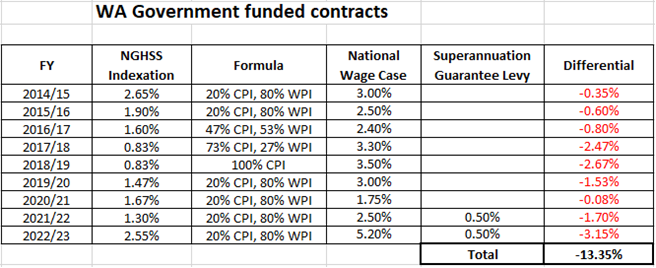
Source: CEWA
Current trends in indexation may increase barriers to industry investment in training, create greater pressure for adaptability and the minimisation of labour costs, and limit opportunities for career development and higher-paid work, all of which have the potential to degrade jobs. The 2022 ACOSS Community Sector Survey revealed that only 14 per cent of community sector organisations across Australia reported indexation arrangements for their main funding source as adequate.[3]
Without an increase by the State Government to the 2022/23 NGHSS indexation, the impacts will include:
- Cuts in community services at a time when extremely high demand is out-stripping supply.
- Decreased job and income security for women, as 80 per cent of the community service workforce are women, with a very high risk there will be a cut in hours or reclassification of positions. The resulting loss of income will drive people out of the industry, especially in the current economic environment of rapidly rising inflation.
- Inability to provide training, mentoring support and personal development opportunities for staff due to lack of sufficient resources. This occurs at a time when there are real shortages of skilled care staff in social services within our state, and many have left to take up better paying work in other sectors.
- Inability to attract new workers to the sector.
Inadequate funding and indexation hold the sector in a low-experience vortex, with entry level workers unable to access ongoing training and skills development opportunities, and experienced workers choosing to exit the system because of the pressure associated with heavy workloads and low pay.
The new Federal Minister for Aged Care, the Hon. Anika Wells recently told ABC 730 Report[4] that the Albanese Government was committed to funding a 25 per cent pay increase for aged care workers if and when the fair Work Commission delivered their decision on sector wages (see also comments on ‘fixing aged care’ by the Prime Minister).[5] A significant increase in pay within federally funded aged care services is likely to see a substantial number of workers in low-paid and insecure roles in state-funded services with similar skill sets choosing to change roles.
Recommendations:
- Indexation and resourcing of State and Federal contracts must be sufficient to ensure award obligations can be met
- Public authorities contract with the not-for-profit community services sector in a manner that supports sustainable and effective service delivery and greater parity in pay and conditions for community services workers.
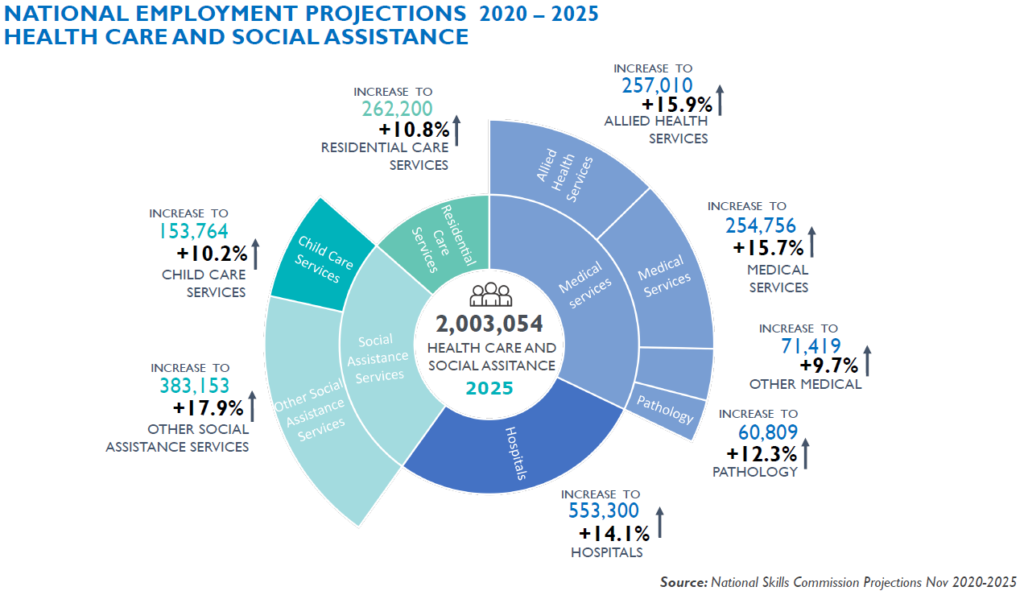
On the job training
WACOSS commends the State Government’s commitment to providing low-cost vocational training in priority areas, and the promotion and development of skill sets to build the capability of the community services and health workforces, as outlined in the Strategic State Government Response to Social Assistance and Allied Health: Future Workforce Skills Report.[6] These commitments will help address financial barriers to education and training opportunities and spur commencements in training.
Further training opportunities to grow Western Australia’s community service sector workforce can be pursued by developing sustainable training regimes and expanding the capacity for skills growth in community service organisations and for their workers. This will require a multifaceted partnership approach between government and the sector that addresses on-the-job training barriers.
Taking a ‘skills ecosystem’ approach that recognises the interdependent nature of employers, workers and training providers in skill formation will help address the complexity of issues in developing and retaining a skilled workforce.[7] Expanding training opportunities in the workplace will help ensure that current government investment in expanding training opportunities with VET providers are not met with high attrition rates due to wider workplace conditions across the sector.
As previously highlighted, indexation rates and procurement models that force organisations to compete for limited funding, influences the propensity for organisations to provide training to new recruits and existing staff across the sector. Organisations must tightly balance how budgets and workloads are managed, particularly when servicing increasing demand, which limits expenditure and opportunity for investment in on the job training and mentoring. On the job training and mentoring, for example, is critical in the disability sector, yet NDIS funding fails to incorporate training of staff into funding models.
Wider workplace conditions, including high levels of casual and part-time work, high levels of unpaid work being performed by workers, and staffing shortages that inhibit meeting service demand, act as additional barriers to work-related training and professional development opportunities. The Community Services and Health Industry Skills Council outlines how the increasingly casualised and insecure nature of employment within the sector has resulted in training costs being shifted more directly on to the employee.[8] They note that as a greater proportion of care work is undertaken by women, it is women workers who tend to be excluded from opportunities for employer sponsored training, limiting career progression and higher-paid employment opportunities.
Evidence on community services training completions within the VET sector suggests that there is a comparatively poor completion rate, suggesting that significant numbers are attracted to a vocation in the caring professions, but are potentially dissuaded as they learn more about the roles.[9] More work is needed to understand the barriers to course completion, such as analysis of student intake and exit surveys, to determine what is dissuading students and to provide better incentives to complete training and take up employment within the sector.
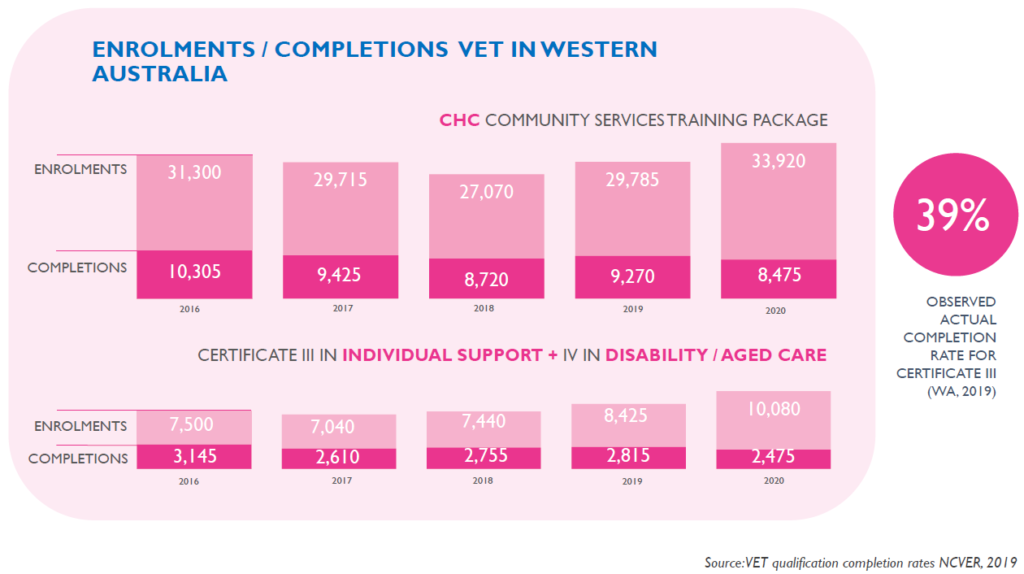
There is a critical shortage of trainers and assessors across the community sector to develop and promote the skills sets to meet its needs. Training should be seen as a partnership between government, training providers and community service organisations, where organisations are supported and funded appropriately to provide on the job training and mentoring. Investing in on-the-job training and professional development provides workers with the space to continuously grow and learn, strengthens the delivery of safe, high-quality care and supports regulatory compliance in sectors such as aged, disability or child care, among others.
Recommendations:
- Support greater links and partnerships between training providers and community service organisations
- Recognise the importance of worker training in procurement policies.
Aboriginal Community Service Sector Workforce Development
The gap in economic participation and life outcomes for Aboriginal people in Western Australia remains significant. The continued impacts of colonisation, racism and intergenerational trauma are sustained by harmful government policies and practices; health, education and support service systems that are inappropriate or inadequate to meet levels of need; poverty and lack of opportunity. Fear and a lack of trust in institutions also play a critical role in lower rates of access to universal and secondary support services, particularly when it comes to justice and child protection services that many families associate with both former stolen generation practices and current harms that have been perpetuated by agencies.
There is a strong need for a greater focus on Aboriginal employment in health, education and community services. Given the projected growth of the service and caring economy, and disproportionately high levels of need for services and support by Aboriginal families and communities, the development of a human services workforce offers an excellent opportunity for generating greater trust in services and for increasing economic participation, helping develop more sustainable and resilient local economies.
A planned and sustained strategy is needed to provide a coordinated approach supporting a skilled Aboriginal human services workforce, and build sustainable Aboriginal organisations and businesses by setting clear employment and training targets. The example of the State Government’s Aboriginal Procurement Policy, which quickly and significantly surpassed its mandated targets,[10] demonstrates how successful this kind of approach can be.
A combination of contracting requirements, additional incentives, and training support is likely to deliver the most effective outcomes. Contracts over a certain size should include minimum employment and training requirements, additional resources made available to leverage increased employment outcomes, and access to targeted support to ensure Aboriginal workers are work-ready, have access to additional training where necessary and their supervisors and co-workers have access to appropriate information and assistance.
There is a significant risk that a strategy that does not address these gaps and challenges would be setting up Aboriginal people, communities and community services to fail. There is a clear role for government to commission employment services at a local or regional level to provide appropriate support. Existing Aboriginal organisations are most likely to be best placed to deliver this support, with many Aboriginal community-controlled organisations having a strong record of outcomes in this area.
In September 2021, the State Government released its first Implementation Plan for Closing the Gap and the Aboriginal Empowerment Strategy. These documents provide the groundwork for a significant shift in the way that government has typically related to Aboriginal people in WA, with a new focus on empowerment, truth-telling, culture and country permeating the direction they set.[11]
The community services sector has a critical role in the delivery of these priorities, partnering with government to create systems and services that are culturally secure and safe, and significantly increasing the proportion of those services that are delivered by Aboriginal community-controlled organisations.
Recommendations:
- Develop an Aboriginal workforce development strategy that provides incentives and support to increase Aboriginal employment in human services contracts
- Establish requirements in State and Federal Government contracts to train and employ people within the local community with a focus on Aboriginal workers
Early Childhood Education and Care Workforce Development
The early education and care (ECEC) workforce play a critical role in both workforce productivity and community wellbeing. It provides both childcare services which enable parents (particularly mothers) to participate in the workforce, and it provides crucial early development, education and wellbeing to children during the critical early years. It is crucial that government policy on workforce, education and social welfare balance both the workforce participation and early development aspects of early learning. A focus on the marketization of the provision of cheap childcare at the expense of sufficient care to support social and emotional development will cost us more in the long-term. It is arguable we are now seeing the generational impacts of inadequate investment in early development and care result in increased rates of anxiety, poor mental health and wellbeing in young adults who are now completing school and entering the workforce.
Childcare services are projected to increase by over 10 per cent nationally between 2020 and 2025, requiring an additional 154,000 workers nationally and around 16,000 in WA. Higher rates of workforce development will be needed if we are to increase the workforce participation rate of women within the WA labour market (now up to 64.5 per cent, vs 74.8 per cent for men) and to increase the proportion of women working fulltime (51.5 per cent, vs 82.6 per cent for men).[12]
There are currently significant barriers to childcare availability and affordability within WA that are creating significant barriers to women’s workforce participation. This is particularly true in regional areas, where a lack of services and the inability to attract and retain skilled staff is at crisis point. Regional centres in the northwest in particular cannot secure ECEC staff, as higher living costs and a lack of affordable local housing have become significant barriers. While local services have been partnering with the resource sector in regional centres in the Pilbara and Kimberley to come up with interim solutions, there is a need for longer-term systemic solutions to support and enable regional development. Childcare availability is also a significant barrier to regional development and workforce participation in the Midwest and Southwest regions, where similar private sector partnerships to set up facilities or access subsidised housing are not an option.
Recent surveys of childcare workers indicate that a high proportion of current workers are dissatisfied with job insecurity, pay and conditions as well as working conditions and future prospects, and intend to leave the industry.[13]
ECEC providers have reported to the Children’s Policy Advisory Council (CPAC)[14] that they face significant capacity constraints in taking on newly graduated staff, without sufficient experienced staff capable of providing ongoing supervision. The sector is concerned that the focus of workforce policy in this area appears to be largely on VET sector training student intake, while ignoring the need to retain existing experienced staff and to provide sufficient support for on-the-job training and upskilling the existing workforce. Service managers caution that unless something is done to address the current retention crisis and reduce the numbers currently leaving the sector, providers may be unable to meet mandated ratios and ensure adequate supervision. Without the experienced staff, childcare centres are not able to meet their compliance requirements and taking on new students is not an option to address this challenge alone, given the ratios and the need for experienced supervisors.
The role of early childhood educator needs to be promoted and recognised for the critical impact it has on a child’s development (and workforce participation and productivity) and mechanisms established where the experienced workers are offered appropriate levels of remuneration and access to ongoing professional development). An effort needs to be made to attract skilled and experienced workers back to the sector to have a more immediate impact on workforce participation in the short-term, while longer-term workforce development policies are implemented.
Western Australia faces some unique challenges in responding to recent national preschool funding reform commitments to ensure our ECEC sector is fit-for-purpose and addressing both participation and early development quality challenges. In relation to increasing workforce participation, the current system divides care between the hours provided through school-based preschool centres delivered through the Department of Education, and the actual hours of care needed by working parents – who then also need to access community-based care and/or long day-care to ensure their children are cared for and safe during work hours. Changes to mandatory entry requirements and qualifications may also result in barriers for existing skilled workers who need to upskill or re-qualify to maintain employment, but do not have access to the professional development support required.
Underemployed workers and those currently excluded from the workforce (such as single parents) face additional systemic barriers to securing and maintaining adequate childcare. Those with insecure work and uncertain hours face significant barriers in planning and scheduling childcare, with care schedules determined in advance, and waiting lists of many months to secure ongoing care or additional hours. Those on unemployment benefits or the single parent pension face further barriers in securing sufficient care entitlement to be able to take up work. There is generally a limited entitlement to care for the unemployed, and so prospective workers need to secure work to be able to access sufficient care, but childcare waitlists mean that they are unlikely to be able to do so in a timely manner. This means in practice that if they are unable to access informal transitional care through family or friends, they are unlikely to be able to transition to work effectively.
Recommendations:
- Encourage and support early childhood centres to provide on-site training and professional development and provide scholarship funding to up-skill experienced staff to provide supervision and mentoring.
- Develop policies and incentives to retain existing skilled early education and care staff, including greater job certainty and improved employment conditions.
- Prioritise the development and provision of childcare services in regional areas as a key support for regional development outcomes.
- Reform funding of preschool care to better support community-based care and increase access to long day care.
Labour market trends across care sector workforces
There is a significant amount of work that has been done in relation to the workforce development needs of the aged care and disability sectors, and recent national inquiries and Royal Commission have highlighted significant challenges in relation to quality and sustainability of services.[15] We expect that detailed submissions will be prepared by the relevant industry and consumer peaks on workforce issues in these sectors.
WACOSS members are concerned by the broader longer-term workforce trends that have emerged over the last decade or more across the aged care, disability and childcare workforces. We believe that there are fundamental underlying structural changes that have occurred to the labour market for the care industries that have been driven by government policy, regulation and funding levers that have undermined both the quality of employment conditions and service outcomes. Human service quality and sustainability has been undermined by service marketisation and individualised funding models, in a manner that is increasingly enabling the exploitation of insecure workers and enabling third-party labour hire agencies to profit, while mission-driven not-for-profit providers lose staff and become increasingly unviable. Gig-economy platforms such as Mable are able to circumvent the regulatory costs and requirements placed on traditional aged and disability care employers in a manner that reduces costs and responsibilities. The end result however, for service users and their loved ones, is lower quality and less reliable services.
When it comes to caring and support services, such as early childhood education and care, or home and community care, service users and carers want and highly value a meaningful and ongoing relationship with the care provider. Quality and consistency of care is predominantly relationship-based, it is important that the care providers know and understand their needs and circumstances. An increasingly casualised and varying workforce, where workers are interchangeable, time-poor and stressed, and must rush from job to job to meet deadlines does not deliver the kind of services the community expects and values. Increasing use of platform-based care is a clear and emerging trend, but it is unclear how well the impacts of this mode of delivery are captured in agency reporting and regulator quality oversight. Service providers report their staff are increasingly choosing better pay and the promise of flexible hours, over ongoing employment under existing funding and award arrangements. As a result, they are finding it hard to recruit new skilled staff and have to increasingly rely on agency staff to meet care commitments, which costs the service more and undermines their ongoing viability.
Recommendation:
- Engage with the Federal Government (via COAG and the National Jobs and Skills Summit) to discuss collaborative reform approaches to service delivery and funding models in aged care, disability and childcare services.
Housing
WACOSS recognises the government’s efforts at attracting skilled interstate and overseas workers to live and work in Western Australia. However, efforts to attract interstate and overseas workers without consideration of where these workers will be able to affordably live is a vital piece missing from the strategic plan to address the state’s skilled labour shortage. Rising rents and a lack of rental properties and affordable housing across Western Australia already has a range of implications for low- to middle-income earners, particularly in regional areas.
In many regional communities, community services cannot keep pace with demand for services, with workforce shortages exacerbated by low-paid, short-term contracts and high cost of living. Attracting and retaining staff is extremely difficult in regional areas as salary packages do not cover housing and rental costs, which are prohibitively high in towns that also service a large number of the fly-in fly-out mining workforce.
With essential services being delivered in regional areas predominantly through short-term contracts and relatively low annual salaries compared to mining or government salaries, the lack of job security coupled with the high cost of living is not only undesirable for most workers, but financially untenable. Insecure, inappropriate and unaffordable housing in regional areas intersects with insecure and precarious work to create barriers to regional employment that limit regional growth and exacerbate boom and bust cycles in regional towns and centres.
In both regional and metropolitan areas, many workers in community services perform physically and emotionally demanding jobs, work long shifts, work during anti-social hours and/or work in high stress situations. Housing stress and insecurity can exacerbate the stress and fatigue resulting from performing their essential duties. That, in turn, can negatively impact service quality, including through an inability to retain more experienced workers in the long term.[16]
WACOSS recognises the government’s action to freeze rents on public sector housing in regional WA to support worker retention. A focus is also needed on improving access to housing for workers in the NGO community service sector. Across Australia, there have been limited federal or state housing programs or policies specifically designed to support key workers outside of the public sector to access housing or the delivery of affordable housing for low- and moderate-income earners.[17]
Housing All Australians Give Me Shelter report found that the national average benefit-cost ratio for Australia in providing adequate social and affordable housing infrastructure is 2:1.[18] Not only is there is a strong underlying business case to create more public, social and affordable housing supply, but also a clear rationale to address housing affordability and availability as part of any effort to attract workers into the state, particularly in regional areas.
Recommendations:
- Develop housing initiatives that ensure provision of accommodation for employees of Non-Government Organisations (NGOs) contracted and funded by the State or Federal Government to provide key services in regional locations
- Incorporate housing costs into service delivery contracts with the State Government in high-cost regional locations to sustain the delivery of funded NGO services.
Recognising the community sector’s value and contribution
It should be noted that the term skill shortage is often a surrogate term for more general recruitment and retainment difficulties in the community service sector. It is unlikely to be possible to attract and retain sufficient workers to meet the growing demand unless pay and working conditions change. Improving community service sector job quality and conditions would also improve quality of care and reduce turnover costs.
It is widely acknowledged that care-giving remains devalued in both social and economic terms. In real terms, the wages associated with performing care work are lower than other forms of work requiring comparable qualifications or skill, and this remains a significant deterrent to attracting and retaining workers for the sector. Workers are consistently poached from the NGO sector by government agencies and the mining sector, particularly in regional areas, who can offer significantly better pay, along with greater job security, and clearer protections for working hours. This is particularly common for the ACCHO sector.
The WA health care and social assistance workforce is highly feminised, with 79 per cent of the workforce female. [19] By comparison to the national average, WA has fewer health care and social assistance workers in fulltime work (51 per cent vs 55 per cent) and more in part-time roles (49 per cent vs 45 per cent). The workforce is also ageing, with 45 per cent of workers aged over 45 years and 22 per cent over 55 years.[20] The female underemployment rate for WA women also remains high at 8.76 per cent (vs 5.2 per cent for men).[21]
Roles in the sector are increasingly being portrayed as a less attractive option for women than those in STEM, Construction or Mining. This is damaging, and can actively discourage people from entering the community service sector workforce. Public perceptions of care work need to be lifted and the extraordinary contribution of workers in caring for Western Australians better recognised and rewarded. Those who chose to pursue roles that involve caring for others should not be made to feel like that are taking a less challenging or valued pathway.
The community sector has immense expertise to offer government, and this has been especially valuable as Australia responds to the multi-faceted crises posed during the pandemic. A collaborative approach between sectors could include mentoring, supervision and personal development that even encourages sharing of staff across sectors and industries (such as Allied Health Professionals), which may assist with attraction of staff to regional areas and enable ongoing professional development.
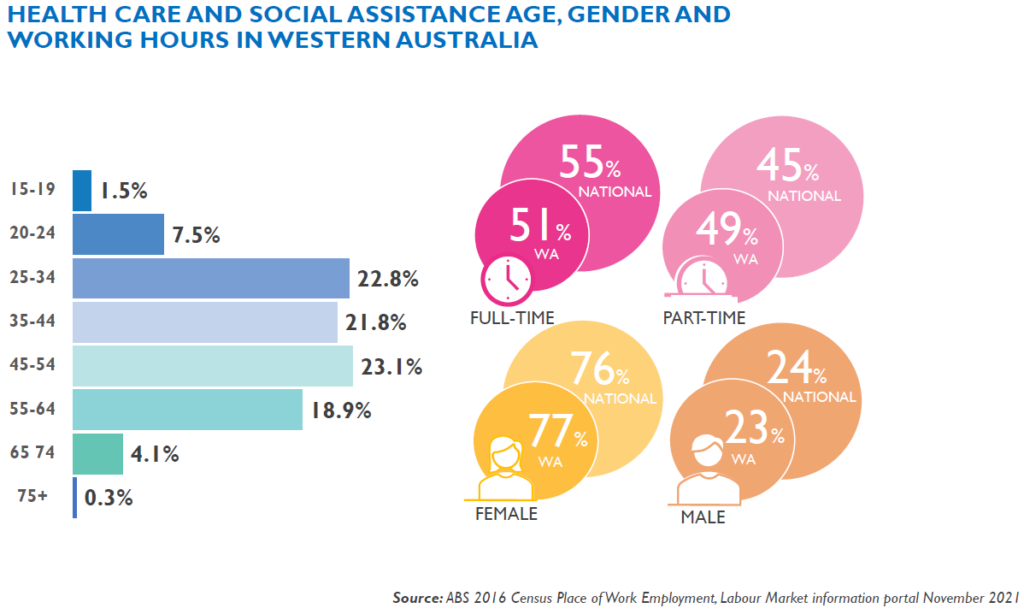 While we often think of mining and construction as the pillars of our state’s economy, health care and social assistance is the largest employing industry in Western Australia, and is projected to grow faster than any other area of the economy over the next five years.[22]
While we often think of mining and construction as the pillars of our state’s economy, health care and social assistance is the largest employing industry in Western Australia, and is projected to grow faster than any other area of the economy over the next five years.[22]
Researched commissioned by the International Trade Union Confederation found that if Australia invested 2 per cent of its GDP in the care industry, it would directly create 356,812 new jobs and raise the employment rate by 2.3 per cent.[23] When both the indirect effects through the supply chain and the induced effects from increased demand within the economy are added, this sees the creation in Australia of 613,597 new jobs and a rise in the employment rate of 4 per cent.
In comparison, the same level of investment in construction only directly increase the employment rate by 0.5 per cent and by 2.5 per cent when indirect and induced effects are considered.
Investing in the care economy also has a profound impact on closing the gender employment gap, with the modelling showing that 79 per cent of the new jobs created by this level of investment would be taken by women, increasing the employment rate for women by 3.7 per cent and decreasing the gender gap by 2.6 per cent. This far outpaces what would be seen in the construction industry, where only 11 per cent of the jobs would be taken by women and their employment rate would rise by just 0.1 per cent.
Importantly, investment in community-based services that focus on prevention and early intervention will reduce the pressure on the health care system, helping to alleviate critical staffing issues, reduce the cost burden and improve health outcomes.
Recommendation:
- Targeted transitional investment in job creation and training in areas of unmet and growing need, such as aged care, disability services, FDV services, ACCO services.
References
[1] Government of Western Australia (2022) Strategic State Government Response to Social Assistance and Allied Health: Future Workforce Skills Report.
[2] ABS Labour Force Survey November 2021, ABS Trend Data.
[3] Cortis N and Blaxland, M (2022) Carrying the costs of the crisis: Australia’s community sector through the Delta outbreak. Sydney: ACOSS
[4] Anika Wells discusses what needs to be done to fix the crisis in aged care | 7.30 – YouTube
[5] Anthony Albanese says Labor plans ‘to fix aged care’ | 7.30 – YouTube
[6] Government of Western Australia (2022) Strategic State Government Response to Social Assistance and Allied Health: Future Workforce Skills Report.
[7] Community Services and Health Industry Skills Council (2012) Identifying Paths To Skill Growth Or Skill Recession: A literature review on workforce development in the community services and health industries. Industry Skills Councils: Australia. (see also the Future Priority Skills Resource)
[8] Ibid.
[9] NCVER (2019) VET Completion rates.
[10] Hon Ben Wyatt (2020) ‘Government’s Aboriginal procurement exceeding expectations’, Media Statements, Government of Western Australia
[11] Hon Stephen Dawson MLC (2021) ‘State Government releases Aboriginal Empowerment Strategy and Closing the Gap Implementation Plan’, Media Statements
[12] WA Women’s Report Card 2022. BCEC & Department of Communities.
[13] United Workers Union (2021) Exhausted, Undervalued and Leaving: The crisis in Early Education
[14] Children’s Policy Advisory Council – WACOSS
[15] For example ACIL Allen (2021) The economic and social impact of the aged care sector in Western Australia
[16] Gilbert, C., Nasreen, Z. and Gurran, N. (2021) Housing key workers: scoping challenges, aspirations, and policy responses for Australian cities, AHURI Final Report No. 355, Australian Housing and Urban Research Institute Limited, Melbourne, https://www.ahuri.edu.au/ research/final-reports/355, doi: 10.18408/ahuri7323901.
[17] Ibid.
[18] SGS Economics and Planning for Housing All Australians (2022) Give Me Shelter: The long-term costs of underproviding public, social and affordable housing
[19] WA Women’s Report Card 2022. BCEC and Department of Communities
[20] ABS 2016 Census Place of work, employment, labour market information (November 2021)
[21] WA Women’s Report Card 2022, op cit.
[22] State Training Board (2019) Social Assistance and Allied Health Workforce Strategy
[23] Jerome De Hanau, Susan Himmelweit, Zofia Tapniewska and Diane Perrons (2016) Investing in the Care Economy: A gender analysis of employment stimulus in seven OECD countries, UK Women’s Budget Group, International Trade Union Confederation




